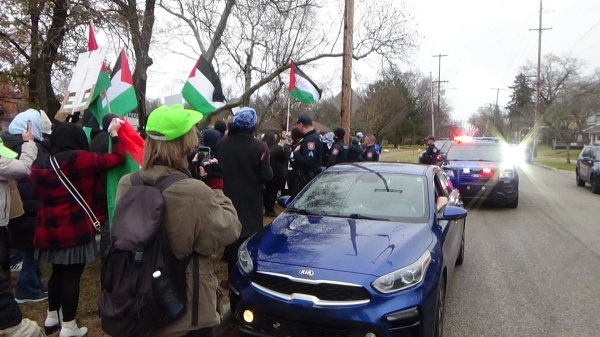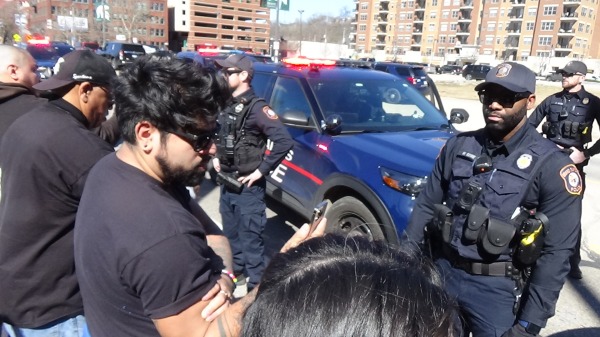The criminalization of dissent in Grand Rapids
It has been very interesting to see how the City of Grand Rapids, through the use of violence workers (also known as the GRPD), has been responding to organized social movements and acts of public dissent.
Shortly after the May 30th, 2020 uprising in Grand Rapids, the GRPD has been somewhat more tolerant of public dissent, at least in the months that followed. However, this has not been the case with BIPOC organizers and activists, whom have been the primary target of GRPD monitoring, harassment and arrests.
This same type of repressive and threatening posture from the GRPD was also directed at Movimiento Cosecha and allies in the immigration justice movement even before the COVID pandemic began, specifically in 2019, when the GRPD threatened to arrest people on May Day of 2019 if they marched in the streets. To be clear, Movimiento Cosecha had marched in the streets on May Day in 2017 and 2018, but the GRPD decided they would no longer tolerate disruption of traffic and commerce. Cosecha and their allies obtained FOIA documents that verified that the GRPD was prepared to use force against people marching in the streets. Here is the Dispersal Announcement the GRPD made:
I am (Rank and Name) of the Grand Rapids Police Department. I am now issuing a Public Safety Order to disperse and I command all those assembled at (specific location) to immediately disperse, which means leave the area. If you do not do so, you may be arrested (cite ordinance or law) or be subject to other police action. Other police action could include the use of Chemical Agents or less-lethal munitions, which may inflict significant pain or result in serious injury. If you remain in the area just described, regardless of your purpose, you will be in violation of city and/or state law. The following routes of dispersal are available: (provide escape route details). You have (provide a reasonable amount of time) minutes to disperse.
The targeting of primarily BIPOC organizers and activists began with actions organized by Defund the GRPD and Justice for Black Lives in the fall of 2020 and throughout 2021. The City of Grand Rapids then hired Eric Winstrom to be the acting Chief of Police for Grand Rapids. Winstrom came from Chicago, a city which has a long and brutal history of repression by the police. (See the book, Chicago’s Reckoning: Racism, Politics, and the Deep History of Policing in an American City.)
Shortly after Winstrom began his tenure as the head of the GRPD, a cop murdered Patrick Lyoya on April 4th of 2022. The very next day, Chief Winstrom, along with other City leaders, held a Press Conference. What was instructive about that Press Conference is how polished Winstrom was as a PR man.
Two months after Patrick Lyoya was murdered, there was another “officer involved shooting, so Chief Winstrom once again held a Press Conference where he started to use the phrase, “the Ferguson Effect.” Winstrom was using that term to make the claim that whenever there is an “officer involved shooting,” that crime usually goes up, especially crime in the Black community. Of course, Winstrom offered to verification of this claim because when people in positions of power make such claims they must be true, according to the dominant narrative used by the commercial news media.
The phrase “Ferguson Effect”, was coined by Heather MacDonald, which Chief Wonstrom named during the Press Conference. What Winstrom didn’t mention is the fact that Heather MacDonald is a senior fellow at the right-wing Manhattan Institute. The use of the phrase, the “Ferguson Effect” was looked at in an article by the media watchdog group, Fairness in Accuracy & Reporting in June of 2015. The article states:
The point of the “Ferguson effect,” though, is not to be accurate. It is instead to distract us from the growing evidence about the magnitude and extent of police use of lethal violence in the United States—as powerfully documented just this week by the Guardian and the Washington Post—and to besmirch the #BlackLivesMatter movement.
It’s a strategy that Republican presidential candidate Barry Goldwater inaugurated in his campaign in 1964, almost single-handedly turning crime into a political weapon against the civil rights movement.
This is exactly what Chief Winstrom was doing, which the local media seemed to be eating up. WOODTV8 repeated the Ferguson Effect claim in their coverage on Friday.
Since last year, the GRPD is targeting more dissident groups and calling un-permitted marches illegal. When the Comrades Collective joined Palestine Solidarity Grand Rapids for a march that began at MLK Park, then went to Rep. Scholten’s home, the GRPD showed up in big numbers and arrested the safety car driver. Safety cars have been used in recent years during marches as a means of protecting those marching from motorists that want to ram into people who are in the streets, just like what happened in Charlottesville in 2017.
The same thing happened during the march for Patrick Lyoya, which took places 2 days after the second anniversary of his murder on April 6th. The GRPD arrested the safety car person and then impounded their car.
However, a few weeks after that happened, two BIPOC activists then received calls from the GRPD to turn themselves in, since one was being charged with a misdemeanor and the other a misdemeanor and a felony.
Just last week, during a protest organized by Palestine Solidarity Grand Rapids, the GRPD once again showed up and arrested 4 people, specifically those that were acting as crowd safety. Here is what the GRCC students newspaper reported:
After protesters marched around the downtown area and disrupted traffic, around 35 Grand Rapids police trailed behind the group stating that they could be subjects of arrest if they didn’t comply with the law. Protestors moved over to the sidewalk while going down Monroe Avenue but marched down the middle of Monroe Center Street.
After Protesters made it back to Monument Park on the corner of Fulton Street and Division Avenue, Police detained four individuals after they were blocking roads according to GRPD Police Chief Eric Winstrom.
“This group has had probably 20 marches since Oct. 6 when Israel was invaded by a group of terrorists,” said Winstrom when referencing when the Palestinian Sunni Islamist group Hamas killed around 1,200 Israeli citizens on Oct. 7. “They (protesters) have not had a permit at any point in time. They continually block streets, creating traffic hazards for individuals. We have been extremely tolerant in accommodating them in their activities, even though they have been illegal…”
It is instructive to note that Winstrom clearly has a Zionist view of what happened in early October, failing miserably to understand the historical context of the actions of Hamas. Winstrom’s lack of clarity on US foreign policy regarding Israel and Palestine aside, what is most important is what he said that is in bold in the previous paragraph. What is at issue here is that Winstrom will not tolerate people engaging in un-permitted marches, especially if those marches are disruptive in nature.
 In Kristian Williams’ book, Life During Wartime: Resisting Counterinsurgency, (a book which discusses the history use of counterinsurgency by police departments – something they learned from the US Military), the author states that one of the primary tactics of counterinsurgency is to engage in “preserving order” and “social management.”
In Kristian Williams’ book, Life During Wartime: Resisting Counterinsurgency, (a book which discusses the history use of counterinsurgency by police departments – something they learned from the US Military), the author states that one of the primary tactics of counterinsurgency is to engage in “preserving order” and “social management.”
Alex Vitale, in his book, The End of Policing, confirm’s this function of social control, when he writes:
The reality is that the police exist primarily as a system for managing and even producing inequality by suppressing social movements and tightly managing the behaviors of poor and nonwhite people: those on the losing end of economic and political arrangements.
We should all expect the repression of social movements and organized dissent to increase in Grand Rapids. We need to expect the worst and plan accordingly when we engage in public acts of disruption. Disruption is a long-held tactic of social movements. Dr. King and the Civil Rights Movement used disruption, which he wrote about:
“We do not need allies more devoted to order than to justice,” Martin Luther King, Jr. wrote in the spring of 1964, refusing calls from moderate Black and White leaders to condemn a planned highway “stall-in” to highlight systemic racism in New York City. “I hear a lot of talk these days about our direct action talk alienating former friends,” he added. “I would rather feel they are bringing to the surface latent prejudices that are already there. If our direct action programs alienate our friends … they never were really our friends.”
It would be understandable, in light of the increased GRPD repression, for people to pull back on direct action. However, we also know that if we are committed to systemic change and collective liberation, we cannot afford to lessen our resistance. We do need to take care of each other and protect those that are the primary targets of this repression, but we must not diminish our resistance, no matter the cost.
I’ll just end with this observation from Kristian Williams’ book, Gang Politics: Revolution, Repression, and Crime, he writes:
“The challenge for liberatory movements, then, is not merely to launch an insurgency capable of overturning the existing power structure but to create new ways of relating, of organizing, of exercising and sharing power, that do not themselves reproduce the logic of a protection racket, like the police.”




Trackbacks
Comments are closed.